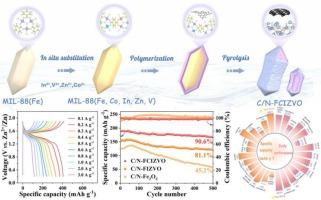Electron structure regulation via Co, in, Zn, and V in-situ substitution for high-quality cathode design of aqueous zinc-ion batteries
IF 9.7
1区 化学
Q1 CHEMISTRY, PHYSICAL
引用次数: 0
Abstract
Traditional manganese oxide cathodes for aqueous zinc-ion batteries usually suffer from sluggish kinetics and irreversible structure degradation, resulting in poor electrochemical activity and stability. The proposal of Zn4SO4·(OH)6·xH2O-assisted deposition-dissolution reaction model promotes the progress of non‑manganese oxide cathodes in certain systems, but the newly proposed model is of limited applications. Based on the model, exploiting high-quality cathodes and feasible performance regulation strategies are essential for the advancement of zinc batteries. Herein, a feasible method is proposed to realize in-situ substitution of Co, In, Zn, and V heteroatoms in Fe3O4 with N-doped carbon coated via the assistance of a Fe-based metal organic framework precursor. The in-situ adulterated metal heteroatoms are proved to have distinct effects on electron structure regulation, triggering more active electron transfer, thus enhancing the efficient interactions with charge carriers. Moreover, the polydopamine derived N-doped carbon shell and unique hollow bipyramidal hexagonal prism structure provide abundant active sites and guarantee sufficient space for electrolyte transport. The hollow structures could homogenize flux distribution and electric field distribution, facilitating high-efficiency and stable energy storage. Consequently, the electrochemical activity, kinetics, and stability could be remarkably optimized. In addition, electrochemical performance improvement mechanisms triggered by in-situ multiple heteroatoms substitution and structure design are revealed by systematic characterizations, computations, and simulations. This study proposes a feasible electron structure regulation strategy triggered by in-situ multiple heteroatoms substitution for non-MnO2 cathode design, which is of great importance for the development of zinc batteries.

通过Co、in、Zn和V的原位替代来调节电子结构,以实现高质量的水性锌离子电池阴极设计
传统的锰氧化物水离子电池阴极存在动力学缓慢、结构不可逆降解的问题,导致其电化学活性和稳定性较差。Zn4SO4·(OH)6·xh2o辅助沉积-溶解反应模型的提出促进了非锰氧化物阴极在某些体系中的进展,但新提出的模型应用有限。基于该模型,开发高质量的阴极和可行的性能调节策略对锌电池的发展至关重要。本文提出了一种可行的方法,通过铁基金属有机骨架前驱体的辅助,将Fe3O4中的Co、In、Zn、V杂原子原位取代为n掺杂碳。原位掺杂金属杂原子对电子结构调控有明显的影响,引发更活跃的电子转移,从而增强了与载流子的有效相互作用。此外,聚多巴胺衍生的n掺杂碳壳和独特的空心双锥体六棱柱结构提供了丰富的活性位点,保证了电解质运输的足够空间。空心结构使磁通分布和电场分布均匀,有利于高效稳定的储能。因此,可以显著优化其电化学活性、动力学和稳定性。此外,通过系统表征、计算和模拟,揭示了原位多杂原子取代和结构设计引发的电化学性能改善机制。本研究提出了一种可行的由原位多杂原子取代引发的非二氧化锰阴极电子结构调控策略,对锌电池的发展具有重要意义。
本文章由计算机程序翻译,如有差异,请以英文原文为准。
求助全文
约1分钟内获得全文
求助全文
来源期刊
CiteScore
16.10
自引率
7.10%
发文量
2568
审稿时长
2 months
期刊介绍:
The Journal of Colloid and Interface Science publishes original research findings on the fundamental principles of colloid and interface science, as well as innovative applications in various fields. The criteria for publication include impact, quality, novelty, and originality.
Emphasis:
The journal emphasizes fundamental scientific innovation within the following categories:
A.Colloidal Materials and Nanomaterials
B.Soft Colloidal and Self-Assembly Systems
C.Adsorption, Catalysis, and Electrochemistry
D.Interfacial Processes, Capillarity, and Wetting
E.Biomaterials and Nanomedicine
F.Energy Conversion and Storage, and Environmental Technologies

 求助内容:
求助内容: 应助结果提醒方式:
应助结果提醒方式:


